Juicy filling wrapped by translucent skin, Har Gow (dim sum shrimp dumplings) is a pleasure both on your palate and to your eyes. Read my detailed recipe to learn how to make it perfectly.
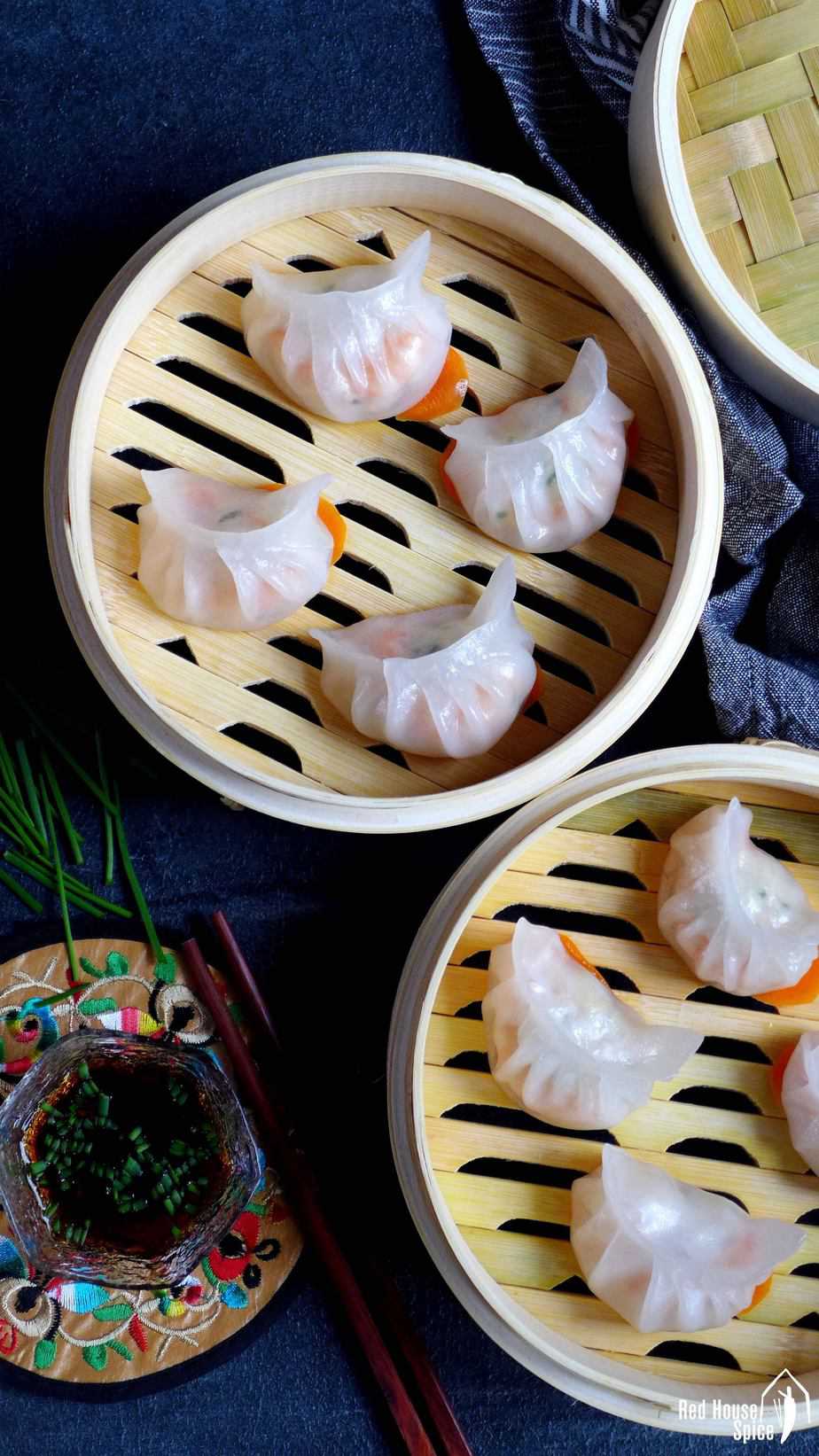
Having made Snow skin mooncakes following my recipe, one of my readers asked me: “Is there any other classic Chinese dishes I can make to use up the leftover wheat starch?” Of course! She reminded me of a wonderful dim sum dish that I always enjoy eating (as well as making). It’s called Har Gow (虾饺, crystal shrimp dumplings), a classic Cantonese dish that you can find in any dim sum restaurants.
Make the perfect dough for Har Gow
The unusual, translucent skin of Har Gow makes it stand out among the Chinese dumpling family. This is why, on many menus, Har Gow is also named “crystal shrimp dumpling (水晶虾饺)”. It’s not difficult at all to make the dough. However, the procedure can easily go wrong if you don’t follow a reliable recipe.
The ideal ratio of the key ingredients
The main ingredients are wheat starch, tapioca starch (can be replaced by cornstarch/potato starch) and water. Through experiments, I found the ideal ratio is 1:1:1. That is to say, these three ingredients share equal volume (Attention: NOT equal weight).
Make sure you use boiling water
Make sure that you pour BOILING water onto the starch mixture. I mean the water that has just been boiled (This is why I don’t use the term “hot water”). Otherwise, you could end up with a bowl of white liquid. That would be a complete disaster (It happened to me once so I know the pain).
Use the dough immediately
When a smooth, soft, slightly elastic dough appears, you can start wrapping the dumplings straight away (unlike regular flour dough that needs to rest for a while). In fact, if you leave the dough too long, its texture will change and thus won’t be workable.
Keep the Har Gow filling tasty & juicy
The filling is the soul of all dumplings. It needs to be flavoursome and moist. Har Gow is no exception.
- The use of water chestnuts and bamboo shoots not only gives the filling a crunchy texture, but they also add a nutty flavour.
- Sesame oil also makes a nice addition. However, excessive usage will overpower the taste of other key ingredients.
- Ginger is there to minimize the fishy flavour. Chive provides a mild oniony taste (You may skip it but do not replace it with spring onion whose taste is too strong for this recipe).
- A bit of lard (or regular cooking oil if you wish) is the key to a juicy filling. And don’t forget to add a bit of starch which keeps the prawn tender.
Put a whole shrimp in each dumpling
I suggest that you mince only half of the shrimp and wrap a whole shrimp in each dumpling (along with some minced filling).
This is my personal preference. When I had my first dim sum meal in a reputable Cantonese restaurant in Beijing years ago, I fell in love with Har Gow at first bite. I really enjoyed the sense of satisfaction given by a whole shrimp inside the dumpling. Another benefit is that the lovely pink colour of the whole shrimp can be seen through the translucent skin. More appetizing this way, isn’t it?
Use a cleaver if you have one
When making Har Gow, the traditional Chinese cleaver comes in handy. Use it if you have one. It will make things easy and it is indeed the authentic technique.
- When shaping the wrappers: Put a ball of dough underneath the side of a cleaver. Press while moving side to side. This way the wrapper can be made very thin and even all around. An important tip: coat the cleaver (and the work surface) with a thin layer of oil to avoid sticking.
- When making the filling: instead of chopping, crush the shrimp under the side of a cleaver by pressing hard with your hand. Give the crushed flesh a quick chop in the end.
However, you don’t need to invest on a cleaver for the sake of making Har Gow. Please feel free to use a regular knife to chop the shrimp and a rolling pin to shape the wrappers.
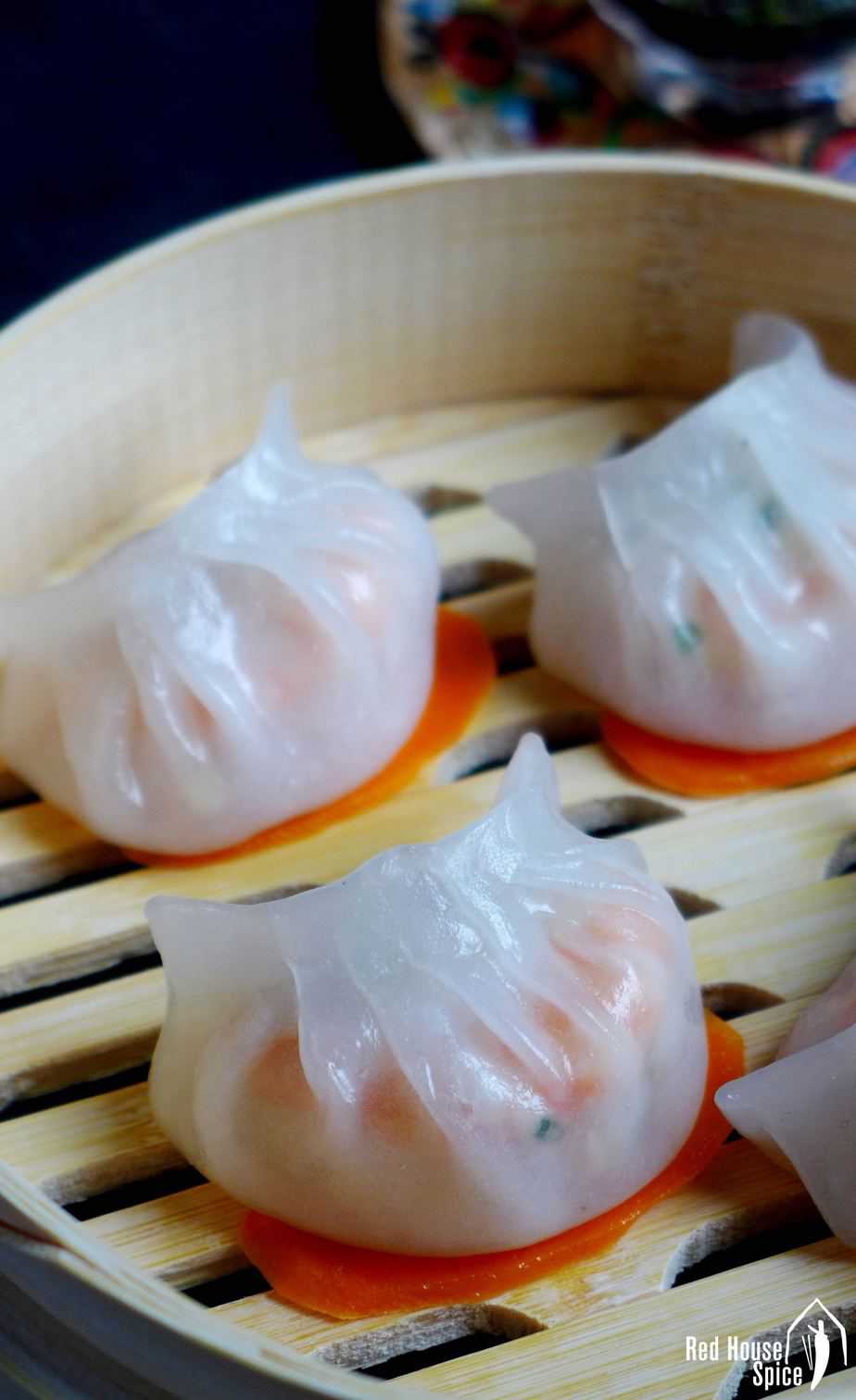
Dive deep into the world of dumplings
If you are a fan of Chinese dumplings, don’t forget to check out my Ultimate Dumpling Guide which includes all aspects of dumpling making:

Har gow: crystal shrimp dumplings (虾饺)
Ingredients
For the filling
- 200 g medium-sized shrimp, peeled and deveined - 7oz
- 3 tablespoon water chestnuts - minced
- 4 tablespoon bamboo shoots - minced
- 1 teaspoon ginger - minced
- 1 tablespoon fresh chive - finely chopped
- 1 teaspoon tapioca starch/cornstarch/potato starch
- 1 teaspoon lard - or cooking oil
- ½ teaspoon pure sesame oil
- ¼ teaspoon salt
- 1 pinch sugar
- 1 pinch white pepper
For the wrapper
- 40 g wheat starch - ⅓ cup
- 40 g tapioca starch/cornstarch/potato starch - ⅓ cup
- 1 pinch salt
- 1 teaspoon lard - or cooking oil
- 80 ml boiling water - ⅓ cup
You also need:
- 12 slices carrot - diagonally cut
Instructions
Prepare the filling
- Pick out 12 shrimp and set aside. Crush the rest of the shrimp by pressing them under the side of a cleaver. Then chop further (use a knife to mince the shrimp if you don't have a cleaver).
- In a mixing bowl, combine whole shrimp, minced shrimp and all the other ingredients for the filling. Place in the fridge.
Make the dough
- Put wheat starch, tapioca starch(or cornstarch/potato starch), salt and lard (or cooking oil) into a mixing bowl.
- Pour in water that has just been boiled (water at lower temptation will result in failure).
- Stir well with a pair of chopsticks, then knead with hands into a smooth, soft dough.
Shape the wrapper
- Make a loop with the dough. Divide it into 12 equal pieces.
- Lightly coat the working surface and the cleaver with oil.
- Roll one piece of dough into a ball. Press it with the side of the cleaver while moving side to side to make a very thin wrapper.
- Gently peel it off the cleaver (you may use a rolling pin to achieve this if you wish). Repeat to make the other wrappers.
Assemble the dumplings
- Place a spoonful of filling in the middle of a wrapper (including one whole shrimp).
- Hold with both hands. Pleat the far side of the wrapper by pressing with the index finger of one hand.
- Push the near side of the wrapper forward with the thumb of the other hand. Seal all around to make a crescent shape.
Steam the dumplings
- Heat up water in the pot on which you are going to place the steamer basket.
- Scatter carrot slices in the basket, then place dumplings on top of each slice (this is to avoid sticking).
- Place the basket in when the water is boiling. Cook with lid on over medium heat for 6 minutes (do not overcook).
Serve
- Leave the dumplings to cool a bit before gently removing them to serve (very hot dumpling skin tends to stick). You may dip them in a vinegary sauce if you wish.
Store
- Keep uncooked dumplings in the freezer for up to 4 weeks. No need to defrost when steaming.
- Put them in a steamer filled with cold water (different from the instructions for fresh dumplings). Cook for 8 minutes after the water starts to boil.
NUTRITION
NUTRITION DISCLOSURE: Nutritional information on this website is provided as a courtesy to readers. It should be considered estimates. Please use your own brand nutritional values or your preferred nutrition calculator to double check against our estimates.


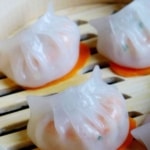

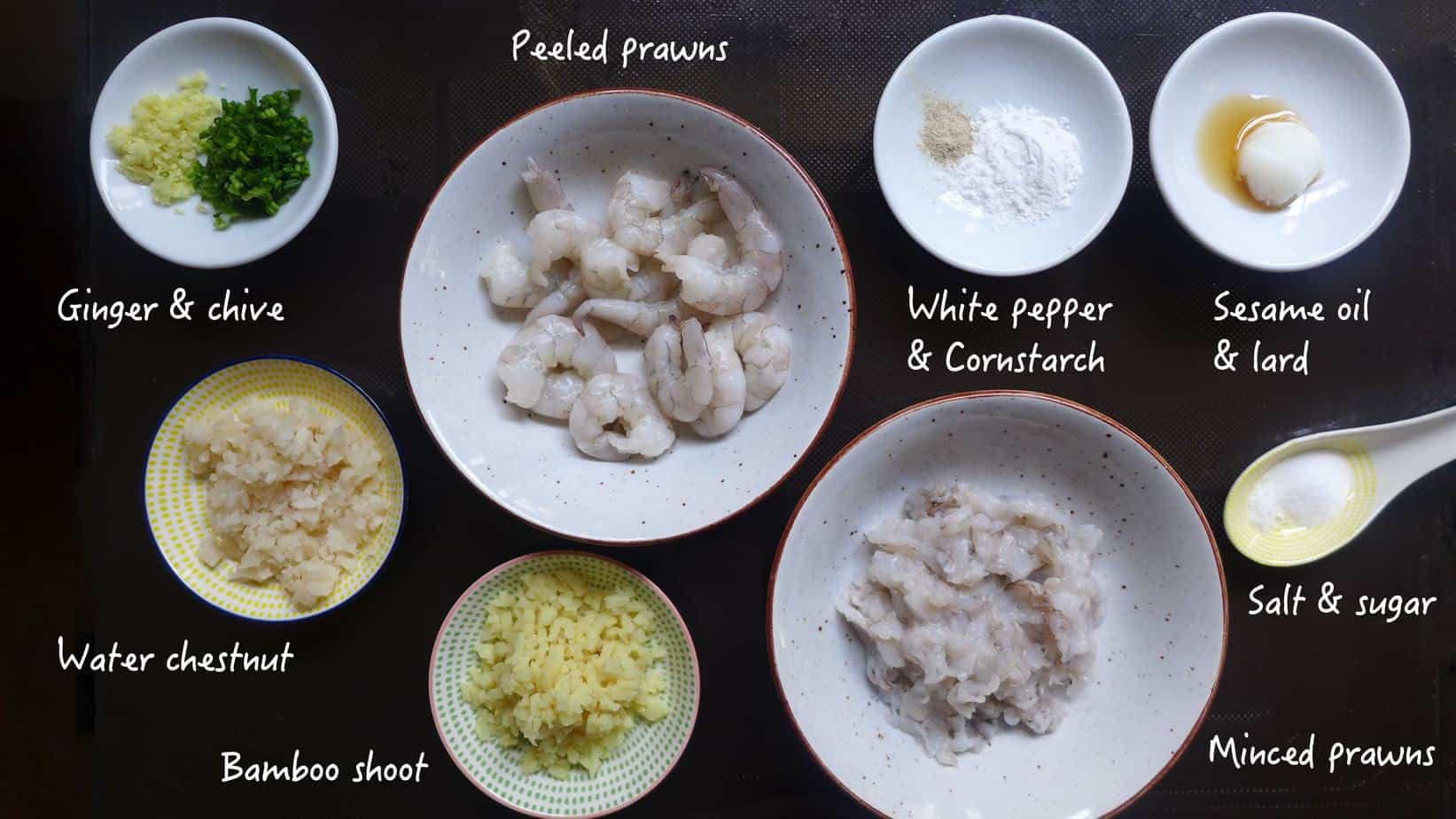
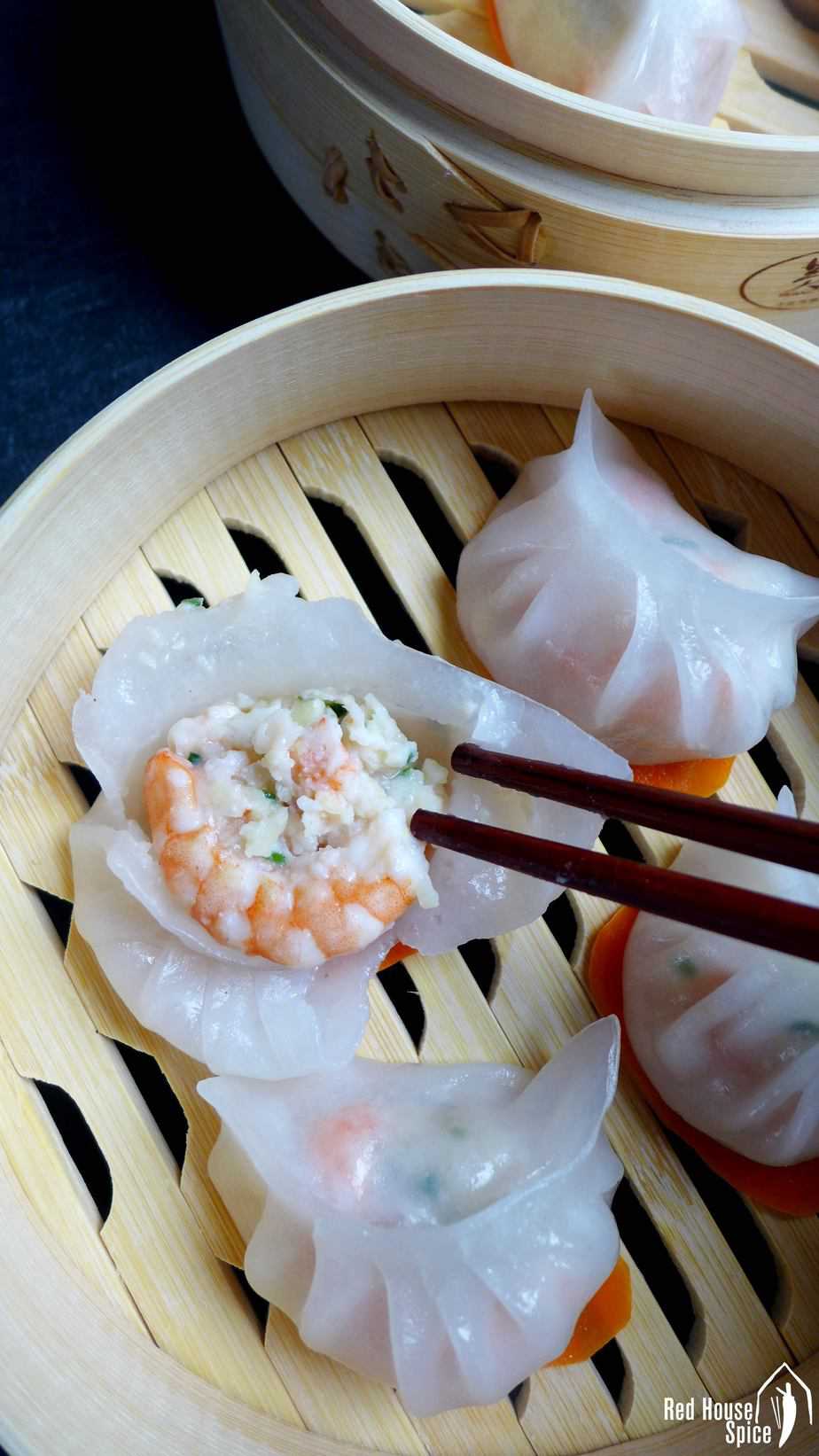






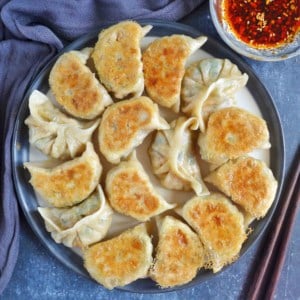
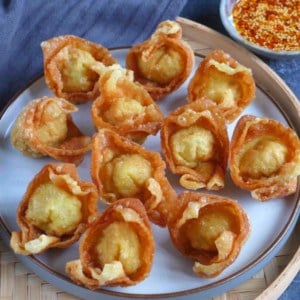
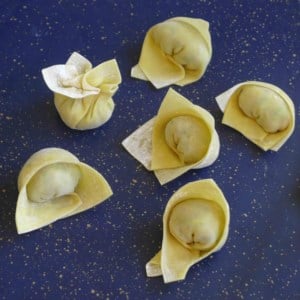
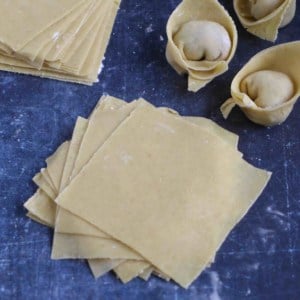
Bamboo shoots and water chestnuts. Is it ok to use the canned variety? I am lucky to live in NYC where we can get the fresh ones but preparing them seems like it may be more work than I need to do if the canned ones are ok and what you use.
Yes, canned bamboo shoots and chestnuts are perfectly fine for this recipe. They are what I use as I don’t have easy access to fresh ones.
Can I make more and freeze those? What would be the best way to go about that?
You can freeze uncooked dumplings and steam them without defrosting. Start with cold water. Cook for 8 minutes after the water starts to boil.
Hi Wei,
Thank you for your recipe. I completely followed your instructions but I really had a hard time with my dough. It easily breaks and it wasn’t near to become a dough. I’m so confused and don’t know what to do. What do you think I did wrong?
Sorry to hear your dough didn’t work well. Based on what you’ve explained, I suspect that it was a little too dry. Add a little more boiling water next time and knead well to combine.
Is this the same skin for Shrimp & Chive dumplings? The round ones that are usually pan fried?
Shrimp and chive filling can be used in any type of Chinese dumplings and cooked in different ways. If the ones you refer to have the same semi transparent look, you may use this recipe for the wrappers.
Is wheat starch a must? I have all the other ingredients and cornstarch but not wheat starch.
Hi Elaine! Wheat starch is a key ingredient for this type of dumpling wrappers if you’re looking for the authentic look and texture.
Hi Wei! I just want to clarify what wheat starch is. Is it the same as plain flour, as that is made from wheat? Other than that, I’m looking forward to trying your recipe!
Hi June! Wheat starch is totally different from plain flour and they’re not interchangeable. It is made from wheat but it’s only the starchy part extracted from wheat.
Okay, I’ll need to rummage around my Asian grocer’s. Is there a substitute if I can’t find wheat starch? I know it gives the skin its stretchiness because cornstarch and tapioca starch don’t really have gluten in them.
Wheat starch is a key ingredient for Har Gow. There isn’t really a substitute. BTW, wheat starch contains next to none amount of gluten. This type of wrappers aren’t as stretchy as regular dumpling wrappers. Wheat starch is here mainly for providing a semi-transparent look.
Understood. Thank you!
To me, Wei, what you have written here is a gift, so I will say *doh jeh* instead of *mmgoy*. You might think you’ve offered a service; I truly consider it a gift.
More years ago than I care to remember, the *one* thing I tried to ‘conquer’ *once* was Har Gow. Mind you, I’d been cooking authentic Chinese food since I was 19, but fully upped my game about 15 years later. My then future-brothers-in-law were stunned that I could make Cantonese Roast Duck, Jook, Chao Fan and more (I’m not Chinese; they were Hong Kong-born to two Cantonese restaurateurs and then emigrated to America); but Har Gow seemed daunting to me. When one of the brothers told me I hadn’t quite gotten it to perfection yet, I put it aside because I knew I needed a better recipe.
I haven’t tried yours yet, of course, but I can tell this has the missing ‘je ne sais quoi’ from back then. I look forward to trying it soon and surprising my *four sons* with one more true Chinatown taste from my kitchen. (I even make Siu Pai Quat, Siu Mai and Kuo Tieh). So as I said, very warmly, *doh jeh*!!! This is quite a gift you’ve offered today!
So happy to hear that Michelle! I hope my recipe helps you find the missing puzzle. Happy steaming!
I want to try this but adding some pork to the filling. What kind of pork do you think would work? Do I cook the port first?
You can add minced pork to the filling for sure. No need to cook it before assembling. Check out my recipe for Shumai which uses pork and shrimp filling.
Hi Wei, I don’t have any bamboo shoots or chestnuts, what can I replace then with? Stitake mushrooms? Or anything else you can recommend. I’m also making a vegetarian version by adding glass noodles, cabbage and shitake mushrooms, chives. Would u recommend anything else for vegetarian version.
You could use shiitake as substitute. Or finely chopped celery as it has a crunchy texture like water chestnuts. For Vegetarian filling ideas, please check my post on How to Make Great Dumpling Fillings, recipes for Pan-fried Vegetarian Dumplings and Vegan Dumplings.
Hi Wei, I absolutely loved your recipe. Living in Florida, I don’t have many options for dim sum, and your recipe helped satisfy my craving. Your instructions were clear and easy to follow. Thank you and keep up the great work!!!
Wonderful to hear that! Making dim sum at home is fun too, right? Glad you’ve enjoyed!